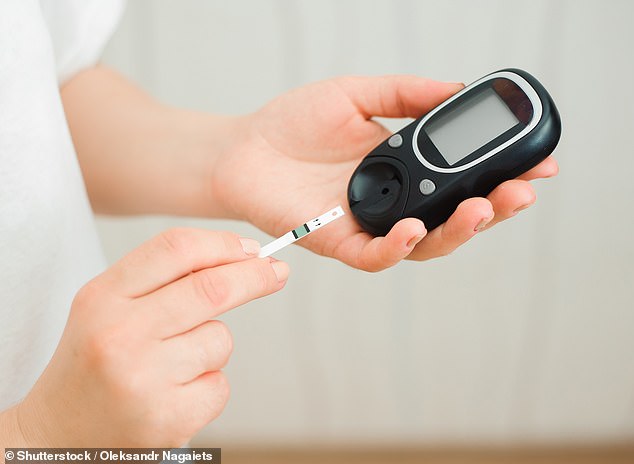Toddlers to be given routine finger-prick blood test to flag up their risk of developing type 1 diabetes
Toddlers can get a routine finger-prick blood test to detect their risk of developing type 1 diabetes – and be given medicine to slow the condition.
The problem, which affects one in 500 children in Britain, occurs when the immune system mistakenly attacks cells in the pancreas, stopping the production of the hormone insulin, which keeps blood sugar levels stable.
Patients must inject regular doses of insulin to stay alive and prevent diabetic ketoacidosis or DKA – a life-threatening condition in which the blood becomes toxic.
About a quarter of children with type 1 are only diagnosed after being admitted to the hospital with DKA. But identifying children as young as two years old who are at risk of diabetes through a blood test – and before they show dangerous symptoms – means new drugs such as the immunotherapy treatment teplizumab can be used. This protects the cells in the pancreas and slows the development of the condition. It could also prevent hundreds of DKA episodes per year.

The problem, which affects one in 500 children in Britain, occurs when the immune system mistakenly attacks cells in the pancreas, stopping the production of the hormone insulin, which keeps blood sugar levels stable.

Diagnosing type 1 diabetes at an earlier stage makes the condition easier to manage
According to experts, this delay can reduce the risk of serious complications of type 1 diabetes, such as limb amputations, heart and kidney disease and blindness, and make the condition easier to manage in the long term.
Type 1 diabetes specialist Professor Parth Narendran, from the University of Birmingham, is leading a trial recruiting 20,000 children to evaluate the screening method. He said: ‘There is already evidence from other European studies that screening can reduce the rate of DKAs and improve glycemic control and mental health. That would save the NHS money.
‘But crucially, there are now drugs in development that can delay the onset of diabetes. Hopefully there will be long-term respite with the use of sequential therapies. The later a person develops the condition, the easier it may be to deal with it. And the less damage done in childhood, the better outcomes can be overall.”
The finger prick test looks for malignant immune proteins called autoantibodies that attack the insulin-producing pancreatic cells.
Professor Colin Dayan of Cardiff University told the European Association for the Study of Diabetes (EASD) conference that children with ‘two or three’ different types of autoantibodies were more than 90 percent more likely to develop type 1 diabetes within 15 years to develop. .
The British screening test, called ELSA, simply involves testing a blood spot from a child’s finger – much like the routine newborn heel prick test, which looks for nine life-limiting conditions.
Children who test positive for various autoantibodies will then undergo further testing to determine if they are at risk for the disease.
These harmful proteins develop over time and are therefore not currently tested in the context of the heel prick test for newborns. But this could change.
“We could do a genetic test as part of the newborn program to find those at highest risk, and then offer them the antibody test when they reach two or three,” says Prof. Narendran.
Before the Covid-19 pandemic, the incidence of type 1 diabetes in children was increasing by about three percent per year. This increased significantly to 14 percent in the first year of the pandemic (2020), followed by a further 27 percent in 2021.
The increase suggests that infection with Covid-19 may trigger the development of type 1 diabetes, although this is not yet fully understood.
Five years ago, epidemiologists predicted that there would be 33,100 children and adolescents (0-19 years) with type 1 diabetes in Britain by 2023, which is expected to rise to 33,800 by 2029. There are likely to be more than 35,000 cases this year and experts now say that by the end of the decade many more people will be suffering from the disease than expected.
Dr. Emily Sims, associate professor of paediatrics at Indiana University School of Medicine in the US, told the EASD conference: ‘Our understanding of type 1 diabetes has now evolved from thinking of it as a disease that develops suddenly, to science that it is something that develops gradually after the appearance of multiple autoantibodies.
‘By screening children and adults to identify individuals with early, pre-symptomatic stages of the disease, we can more accurately predict when they will first need insulin and prevent life-threatening DKA episodes.’
It is understood there is an ‘ongoing dialogue’ with the government’s National Screening Committee about the possibility of screening for type 1 diabetes.
A spokesperson for type 1 diabetes charity JDRF, which funds ELSA along with the charity Diabetes UK, said: ‘We hope this trial will give the government the evidence it needs to roll out screening for children.’
The ELSA study is recruiting children aged three to 13 for screening, but Prof Narendran says younger children may be able to participate.
He adds: ‘The German study looked at screening children aged two to five. We started at age three just to give children another year to develop the autoantibodies. But a lot of families are asking if we can start testing them younger, so we’re going to try to reduce it to two.’
